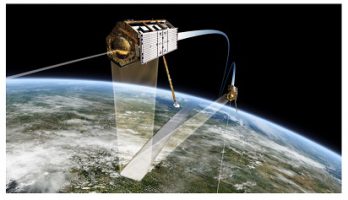PolymPart: Thesis student Jan Reifenhäuser at the Koblenz University of Applied Sciences explores the uses of 3D printing in creating improved antennas for multiple applications, outlined in ‘Investigation of a Plastic Printed Slotted Waveguide Antenna for Airborne SAR Applications.’ Reifenhäuser’s interest in creating antennae are directly related to a new project at the German Aerospace Center, as they begin working with synthetic aperture radar (SAR) technology in Ka-band—more specifically, the Ka-band PolInSAR system.

Due to requirements for excellence in mechanical accuracy, 3D printing was chosen as the manufacturing method with temperature-resistant plastic. The researchers involved in the project created two different antenna prototypes with plastic, and brass. Because the German Aerospace Center is so vast, boasting numerous different institutes at 20 different German sites, their resources are considerable in research for applications such as:
Aeronautics
Space
Energy
Transport
Digitization
Security
Space Administration
TanDEM-X and TerraSAR-X SAR satellites, flying in formation to create an interferometric system.
In the Microwaves and Radar Institute, however, they focus solely on researching new technologies related to radar, remote sensing, and specifically for this study, airborne and satellite-based radar systems with synthetic aperture—used for better accuracy in providing data—from space, for example. SAR interferometry can act as an extension, with two different sensors taking images of the same thing. The altitude of objects being monitored can be precisely figured, which is helpful in mapping applications. Radar signals can also be used to obtain greater amounts of data about features such as surface condition.
“When reflected on ground, the polarization may change depending on the reflecting surface,” states Reifenhäuser. “This change is detected upon receiving the echo and conclusions can be drawn about the surface. This procedure is called polarimetry.”
Currently, the institute uses research aircraft (like the Do228-212 aircraft) for compiling SAR images, with their interest in such applications and the field of satellite-based systems increasing—and expanding toward Ka-band SAR systems as there is growing interest worldwide too. The Ka-band is distinguished by its shorter wavelength, and the ability to use ‘lower penetration depth’ into volume. This lends its uses to applications requiring precision, like the weather and climate research.
DLR’s Do228-212 research aircraft with F-SAR system.
So far, however, scientists have had limited experience dealing with Ka-band SAR systems including single pass interferometric or polarimetric capabilities—there are increasing numbers of Ka-band hardware components becoming available to consumers through the commercial market though. In creating their Ka-band PolInSAR Demonstrator, DLR steps into the realm of aircraft-based Ka-band PolInSAR systems.
The 3D printed antenna had to be created with the following considerations:
Center frequency of 35.75 GHz
Bandwidth of at least 500 MHz
Beam-width of 30° in elevation and 5° in azimuth
Altitude range of 0 m up to 6000 m (the military test standard)
Polarimetric operation
Testing was completed both with simulated exercises and physical measurement, with a brass antenna serving as a reference point for the 3D printed version. Both devices were tested at 21 °C in DLR’s compact test range (CTR), leaving the researchers to further to investigate ‘influence of temperature.’ Stating that it is advisable for using several single radiators to better define radiation characteristics, the researchers combined several of them together into a ‘group antenna,’ achieved by creating ‘slots’ in a waveguide wall.
Ultimately, the Ka-band PolInSAR system consists of multiple antennas set up to encourage beam forming, with the horizontal and vertical antennas alternated, resulting in a very small distance between polarizations. The researchers outsourced 3D printing of one prototype, while the other was milled from brass using traditional manufacturing methods. The 3D printed antenna was made of plastic but finished with a layer of copper. Thermal expansion had the greatest impact on both antennas—but the researchers also found very small differences between antenna gain and input reflection.
The team also noted that while testing the prototypes for the impacts of temperature change, they noticed a transformation in the signal phase. They also noted higher error in phase assignment as increased numbers of elements were arranged in the waveguide array. Ultimately however, similar antennas set at different frequency ranges exhibited the same character adjustments.
“Looking at the single element of the antenna array, it can be said that the small ascertained pointing error is compensated by the symmetry of the antenna due to the central feed,” concluded the researchers. “Printed plastic is therefore suitable as material for the antenna array of the Ka-band PolInSAR system.”
Some industries have actually been using 3D printing for decades, mainly for prototypes, but in recent years, many more functional parts are being fabricated and relied on—whether created in plastic, metal, or other materials, from conformal phased array antennas to sensors and wearablesand even wearable antennas. Find out more about antennas being 3D printed by the German Aerospace Center here.
What do you think of this news? Let us know your thoughts; join the discussion of this and other 3D printing topics at 3DPrintBoard.com.
Source: https://3dprint.com/243898/german-aerospace-center-creating-3d-printed-polymer-antennas-for-synthetic-aperture-radar-sar-systems/
